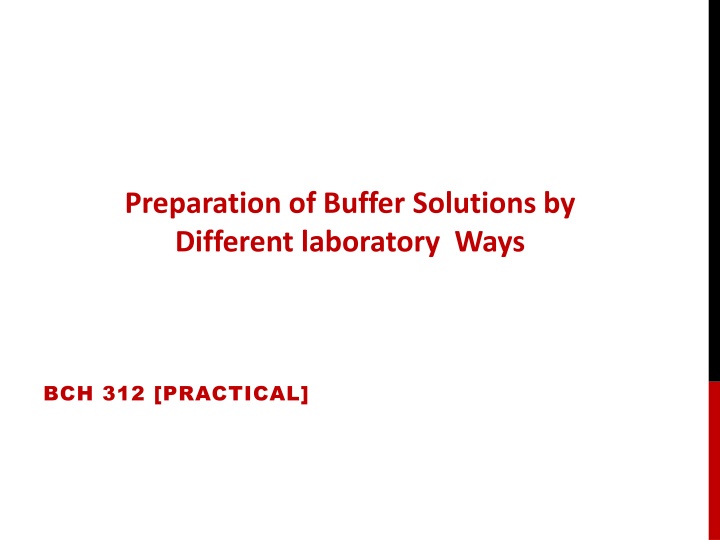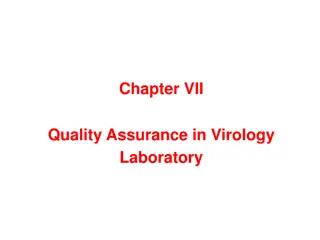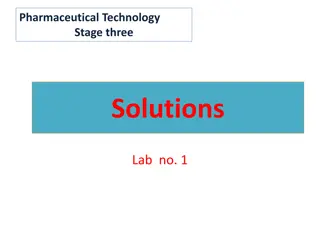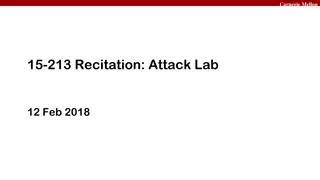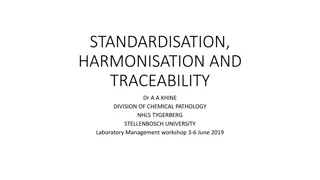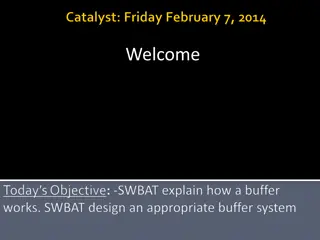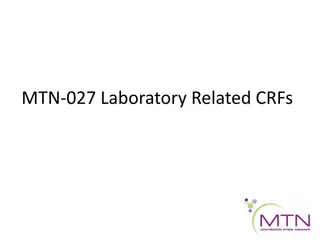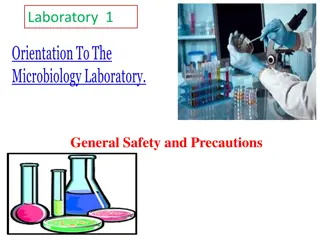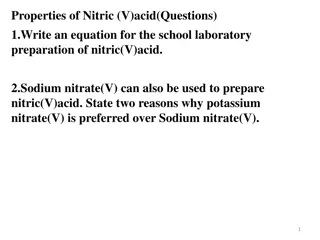Preparation of Buffer Solutions by Different laboratory Ways
Learn how to prepare a buffer using different laboratory methods. Understand the dissociation of triprotic acids like phosphoric acid and the steps involved in preparing sodium phosphate buffer. Follow practical examples to calculate moles of ionic species in a buffer and choose pKa values for optimal pH.
Download Presentation

Please find below an Image/Link to download the presentation.
The content on the website is provided AS IS for your information and personal use only. It may not be sold, licensed, or shared on other websites without obtaining consent from the author.If you encounter any issues during the download, it is possible that the publisher has removed the file from their server.
You are allowed to download the files provided on this website for personal or commercial use, subject to the condition that they are used lawfully. All files are the property of their respective owners.
The content on the website is provided AS IS for your information and personal use only. It may not be sold, licensed, or shared on other websites without obtaining consent from the author.
E N D
Presentation Transcript
Preparation of Buffer Solutions by Different laboratory Ways BCH 312 [PRACTICAL]
Objective: -To learn how to prepare a buffer by different laboratory ways.
Dissociation of triprotic acid: Triprotic acid is acid that contain three hydrogens ions. It dissociates in solution in three steps, with three Ka values. phosphoric acid is an example of triprotic acid . It dissociates in solution as following:
The buffer can be prepared in any one of several ways: For example if you was asked to prepare sodium phosphate buffer [ e.g. NaH2PO4/ Na2HPO4]: you can by .. 1. By mixing NaH2PO4(conjugate acid ) and Na2HPO4(conjugate base) in the proper proportions. 2. By starting with NaH3PO4and converting it to NaH2PO4, plus Na2HPO4by adding the proper amount of NaOH. 3. By starting with NaH2PO4and converting a portion of it to Na2HPO4by adding NaOH. 4. By starting with Na2HPO4and converting a portion of it to NaH2PO4by adding a strong acid such as HCl. 5. By starting with Na3PO4and converting it to Na2HPO4, plus NaH2PO4by adding HCl. 6. By mixing Na3PO4and NaH2PO4in the proper proportions.
H3PO4 H2PO4- HPO42- PO43- NaOH accept H+ HCl donate H+
Example: Prepare 0.1 liters of 0.045 M sodium phosphate buffer, pH=7.5 [pka1= 2.12, pka2= 7.21 and pka3= 12.30] a) From concentrated (15M) NaH3PO4and solution of 1.5 M NaOH . b) From solid NaH2PO4 and solid NaOH. 1st, write the equations of Dissociation of phosphoric acid and the pka of corresponding ones: Because phosphoric acid [H3PO4] has (Triprotenation : it has 3 dissociation phases) so,
2nd, choose the pka value which is near the pH value of the required buffer, to be able to know the ionic species involved in your buffer: The pH of the required buffer [pH =7.5] is near the value of pka2 Consequently , the two major ionic species present are H2Po4-( conjugate acid ) and HPO4-2(conjugate base ). with the HPO4-2predominating { since the pH of the buffer is slightly basic }
Since the buffer concentration is 0.045M, so assume [A-] = y , [HA]= 0.045 y 3rd , calculate No. of moles for the two ionic species in the buffer : PH =PKa2+ log [ HPO4-2] / [H2PO4-] Assume [A-] = y , [HA]= 0.045 - y 7.5 = 7.2 + log ( y / 0.045-y ) 7.5-7.2 = log ( y / 0.045-y ) 0.3= log( y / 0.045-y ) antilog for both sides: 2=( y / 0.045-y) y= 0.09 - 2 y 3 y = 0.09 Note that : [A-] = HPO4-2 [HA] = H2PO4- y= 0.9/3 = 0.03 M conc. of [ HPO4-2] = [A-] = y So, conc. of [H2PO4-] =[HA] = 0.045 y = 0.045- 0.03 = 0.015 M - No. of moles of = HPO4-2(A-)= M x V = 0.03 x 0.1 = 0.003 moles. - No. of moles of H2PO4-(HA)= M x V = 0.015 x 0.1 = 0.0015 moles.
[Note that Total no. of moles of phosphate buffer= M x V= 0.045 x 0.1 = 0.0045 moles]. [Regardless of which method is used , the first step involves calculating number of moles and amounts of the two ionic species in the buffer]. Note: 1- H2PO4-(HA) = (NaH2PO4). 2- HPO4 -2 (A-) = (Na2HPO4).
Now, to prepare the required buffer: a) From concentrated (15M) NaH3PO4and solution of 1.5 M NaOH . Calculations: Start with 0.0045 mole of H3PO4and add 0.0045 moles of NaOH to convert H3PO4completely to H2PO4-(HA) (NaH2PO4),then add 0.003 moles of NaOH to convert H2PO4-to give HPO4 -2 (A-): No. of moles needed of NaOH= 0.0045+0.003= 0.0075 moles Volume of NaOH needed= no.of moles / M = 0.0075/ 1.5 = 0.005 L = 5 ml Volume of H3PO4 needed =no.of moles / M = 0.0045/ 15 =0.0003 L = 0.3 ml Add 5ml of NaOH to the 0.3 ml of concentrate H3PO4, mix ; then add sufficient water to bring the final volume to 0.1 liters (100 ml), and check the pH Remember that the two ionic species involved in the buffer are:
prepare the required buffer, a) From concentrated (15M) NaH3PO4and solution of 1.5 M NaOH . CONT, H3PO4 0.0045 moles NaOH 0.0045 moles H2PO4- 0.0045 moles NaOH 0.003 moles H2PO4- HPO42- 0.003 moles 0.0015 moles
Remember that the two ionic species involved in the buffer are: Now, to prepare the required buffer: b) From solid NaH2PO4 and solid NaOH. Calculations Start with 0.0045 mole of NaH2PO4(HA) and add 0.003 moles of NaOH to convert NaH2PO4 to give Na2HPO4(A-): - Weight in grams of NaH2PO4 needed = no. of moles x mwt =0.0045 x 119.98 = 0.54 g - Weight in grams of NaOH needed = no. of moles x mwt = 0.003 x 40 =0.12 g So, Dissolve the 0.548g of NaH2 PO4and 0.12g of NaOH in some water, mix ; then add sufficient water to bring the final volume to 0.1 liters (100 ml), and check the pH. Note Conc.=concentration
prepare the required buffer, b) From solid NaH2PO4 and solid NaOH. CONT, H2PO4- 0.0045 moles NaOH 0.003 moles H2PO4- HPO42- 0.003 moles 0.0015 moles
As in the lab sheet, Prepare 0.1 liters of 0.045 M sodium phosphate buffer, pH=7.5, [pKa1= 2.12, pKa2 = 7.21 and pKa3 = 12.30]: a) From concentrated (15M) H3PO4and solution of 1.5 M NaOH : Add 5ml of NaOH to the 0.3 ml of concentrate H3PO4, mix ; then add sufficient water to bring the final volume to 0.1 liters (100 ml), and check the pH. b) From solid NaH2PO4and solid NaOH : Dissolve the 0.548g of NaH2PO4and 0.12g of NaOH in some water, mix ; then add sufficient water to bring the final volume to 0.1 liters (100 ml), and check the pH.
HOMEWORK: Prepare 0.1 liters of 0.045 M sodium phosphate buffer, pH=7.5, [pka1= 2.12, pka2 = 7.21 and pka3 = 12.30]: c) You are provided with solid Na2HPO4and 2M HCl. d) You are provided with solid Na3PO4and 2 M HCl .
